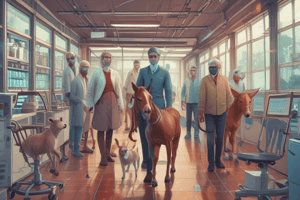Podcast
Questions and Answers
If a disease occurs at a fairly stable rate, it is said to be:
If a disease occurs at a fairly stable rate, it is said to be:
- Endemic (correct)
- Pandemic
- Sporadic
- Epidemic
Expected prevalence of a disease is:
Expected prevalence of a disease is:
- The number of new cases of a disease over a period of time.
- The expected occurrence of a disease based on past observations. (correct)
- The total number of cases of a disease over a period of time.
- The anticipated geographical spread of a disease based on past observations.
Which of the following is an indirect infectious disease transmission mode?
Which of the following is an indirect infectious disease transmission mode?
- Vehicle (correct)
- Person to person
- Animal
- Environment
- Vertical
Which of the following diseases is noncommunicable, meaning that it is not spread from person to person?
Which of the following diseases is noncommunicable, meaning that it is not spread from person to person?
Which of the following is not a responsibility of epidemiologists?
Which of the following is not a responsibility of epidemiologists?
The common cold is a(n) _________ disease.
The common cold is a(n) _________ disease.
Which of the following are examples of endogenous sources of transmission?
Which of the following are examples of endogenous sources of transmission?
If you have isolated a suspected pathogen in pure culture from a diseased laboratory animal, what would be the next step to confirm the organism is causing the disease?
If you have isolated a suspected pathogen in pure culture from a diseased laboratory animal, what would be the next step to confirm the organism is causing the disease?
During which of the five stages of disease would you expect first symptoms to appear?
During which of the five stages of disease would you expect first symptoms to appear?
An ________ is a widespread disease outbreak in a particular region during a specific time frame.
An ________ is a widespread disease outbreak in a particular region during a specific time frame.
If an epidemic spreads to numerous countries it is called a(n) _______.
If an epidemic spreads to numerous countries it is called a(n) _______.
The _______ of an infectious agent is the animate or inanimate habitat where the pathogen is naturally found.
The _______ of an infectious agent is the animate or inanimate habitat where the pathogen is naturally found.
Vertical transmission, a specialized form of ____________, occurs when the pathogen passes from mother to offspring during pregnancy, during delivery, or through breast milk.
Vertical transmission, a specialized form of ____________, occurs when the pathogen passes from mother to offspring during pregnancy, during delivery, or through breast milk.
The time when the replication of the infectious agent is brought under control and symptoms start to resolve is called the:
The time when the replication of the infectious agent is brought under control and symptoms start to resolve is called the:
Which of the following is not a strategy used to break the epidemiological triangle?
Which of the following is not a strategy used to break the epidemiological triangle?
True or False: Bacteria are the most common cause of HAIs.
True or False: Bacteria are the most common cause of HAIs.
Select all the most common bacterial pathogens that are associated with HAIs.
Select all the most common bacterial pathogens that are associated with HAIs.
Which of the following terms describes the total number of persons afflicted with a particular infectious disease in the entire population?
Which of the following terms describes the total number of persons afflicted with a particular infectious disease in the entire population?
Transmitting illness via food is what type of transmission?
Transmitting illness via food is what type of transmission?
Flashcards are hidden until you start studying
Study Notes
Disease Classification
- A disease occurring at a stable rate in a specific area is known as endemic.
- Expected prevalence is determined by the anticipated occurrence of a disease based on historical data.
Modes of Disease Transmission
- Indirect infectious disease transmission can happen through vehicles.
- Noncommunicable diseases do not spread between individuals; an example is Giardiasis.
- Endogenous transmission sources include pathogenic organisms like Candida albicans.
Epidemiology Responsibilities
- Epidemiologists focus on controlling disease vectors, quarantining infectious patients, and providing public education.
- The development of antibiotics is not a direct responsibility of epidemiologists.
Disease Phases
- The common cold is classified as an endemic disease.
- Symptoms first appear during the prodromal phase.
- The period when an infectious agent's replication is controlled and symptoms begin to resolve is called the period of decline.
Outbreak Terminology
- A widespread disease within a region during a specific time frame is termed an epidemic.
- If an epidemic extends globally, it is labeled a pandemic.
- The reservoir is where a pathogen naturally resides, either in animate or inanimate forms.
Transmission Types
- Vertical transmission occurs when pathogens transfer from mother to offspring, classified as direct contact transmission.
- Transmitting illness through contaminated food is categorized as vehicle transmission.
Public Health Facts
- True: Bacteria are the most common causes of healthcare-associated infections (HAIs).
- Common HAIs include pathogens like Staphylococcus aureus and Clostridium difficile.
- Prevalence refers to the total number of individuals afflicted with an infectious disease within a population.
Epidemiological Strategies
- Common strategies to break the epidemiological triangle include public education, quarantine, and vector control.
- Alternative prevention methods are not considered a standard strategy in epidemiology.
Studying That Suits You
Use AI to generate personalized quizzes and flashcards to suit your learning preferences.




